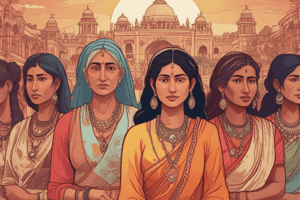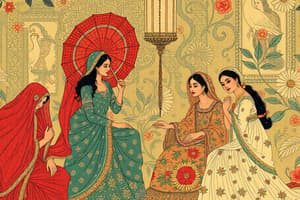Podcast
Questions and Answers
What major barrier did Ambedkar face in his life?
What major barrier did Ambedkar face in his life?
- Political opposition
- Caste system (correct)
- Economic challenges
- Religious differences
Rammohan Roy was a religious reformer who supported the caste system.
Rammohan Roy was a religious reformer who supported the caste system.
False (B)
What was the aim of the Prarthana Samaj?
What was the aim of the Prarthana Samaj?
To promote spiritual equality among all castes.
Ghasidas started the __________ movement to raise the status of leather workers.
Ghasidas started the __________ movement to raise the status of leather workers.
Which of the following organizations was active in promoting social reform?
Which of the following organizations was active in promoting social reform?
The lower castes organized movements against caste discrimination by the end of the 19th century.
The lower castes organized movements against caste discrimination by the end of the 19th century.
What were some examples of labor that low caste people provided in cities?
What were some examples of labor that low caste people provided in cities?
Match the social reformers with their contributions:
Match the social reformers with their contributions:
Which of the following statements about Raja Rammohan Roy is incorrect?
Which of the following statements about Raja Rammohan Roy is incorrect?
The Aligarh Movement aimed to educate Hindus in India.
The Aligarh Movement aimed to educate Hindus in India.
What major change in education for women occurred by the end of the 19th century?
What major change in education for women occurred by the end of the 19th century?
Raja Rammohan Roy founded the __________ in 1830.
Raja Rammohan Roy founded the __________ in 1830.
When was the Hindu Widow Remarriage Act passed?
When was the Hindu Widow Remarriage Act passed?
Match the following figures with their contributions:
Match the following figures with their contributions:
By the early 19th century, printed materials such as books and newspapers began to appear in India.
By the early 19th century, printed materials such as books and newspapers began to appear in India.
What did Indian women do towards the end of the 19th century to contribute to social reform?
What did Indian women do towards the end of the 19th century to contribute to social reform?
Flashcards
Caste System
Caste System
The rigid social hierarchy in Hindu society that dictates an individual's social status based on their birth.
Untouchability
Untouchability
The practice of treating people of lower castes as inferior and keeping them separate from the upper castes.
Social Reform Movement
Social Reform Movement
A movement that took place in India during the 19th century, seeking to reform social practices and challenge rigid traditions.
Prarthana Samaj
Prarthana Samaj
Signup and view all the flashcards
Paramhans Mandali
Paramhans Mandali
Signup and view all the flashcards
Satnami Movement
Satnami Movement
Signup and view all the flashcards
Migration of Labor
Migration of Labor
Signup and view all the flashcards
Social Equality and Justice
Social Equality and Justice
Signup and view all the flashcards
Hierarchy
Hierarchy
Signup and view all the flashcards
Brahmo Samaj
Brahmo Samaj
Signup and view all the flashcards
Sati
Sati
Signup and view all the flashcards
Aligarh Movement
Aligarh Movement
Signup and view all the flashcards
Hindu Widow Remarriage Act (1856)
Hindu Widow Remarriage Act (1856)
Signup and view all the flashcards
Social Reform Movements of 19th Century India
Social Reform Movements of 19th Century India
Signup and view all the flashcards
Impact of Print Media in 19th Century India
Impact of Print Media in 19th Century India
Signup and view all the flashcards
Singh Sabha Movement
Singh Sabha Movement
Signup and view all the flashcards
Periyar
Periyar
Signup and view all the flashcards
Dravida Kazhagam
Dravida Kazhagam
Signup and view all the flashcards
Dravida Munnetra Kazhagam
Dravida Munnetra Kazhagam
Signup and view all the flashcards
Henry Louis Vivian Derozio
Henry Louis Vivian Derozio
Signup and view all the flashcards
Young Bengal Movement
Young Bengal Movement
Signup and view all the flashcards
Muhammadan Anglo-Oriental College
Muhammadan Anglo-Oriental College
Signup and view all the flashcards
Study Notes
Social Reform Movements in 19th and 20th Century India
- The caste system, a hierarchical social structure, existed in India since ancient times, creating social inequalities.
- Early 19th century saw a shift in social customs and practices. Books, newspapers, and magazines emerged.
- Raja Rammohan Roy founded the Brahmo Samaj in 1830, criticizing social evils like sati, child marriage, and idolatry.
- Dayanand Anglo-Vedic schools were established later in the century.
- By the 1880s, Indian women began entering universities and working as teachers and doctors.
- Women were actively involved in reform efforts by writing books, founding schools, and publishing magazines.
- In the 20th century, leaders like Jawaharlal Nehru and Subhas Chandra Bose emphasized education for India's future progress.
The Aligarh Movement
- Sir Syed Ahmed Khan led the Aligarh Movement to educate Indian Muslims.
- The movement established the Muhammadan Anglo-Oriental College (later Aligarh Muslim University) in 1875.
- The movement aimed to protect Islam, persuade Muslims to learn English, and secure a significant role in the country's administration.
The Singh Sabha Movement
- A socio-religious movement within Sikhism, started by a group of Sikh religious leaders.
- The movement sought to eliminate superstitious practices and caste distinctions within Sikhism.
- The Singh Sabha movement aimed to promote Sikh education and practice reform through publications.
Other Reform Movements
- The Brahmo Samaj, founded in 1830 by Raja Ram Mohan Roy, emphasized monotheism and challenged various Hindu traditions.
- The Brahmo Samaj criticized the caste system, child marriage, sati, and idol worship.
- The Prarthana Samaj focused on the worship of one God, but also campaigned for reform, aiming for the equality of women and depressed classes.
- Swami Vivekananda founded the Ramakrishna Mission, a philanthropic organization promoting the ancient Hindu philosophy of Vedanta, established healthcare, disaster relief, and education centers across India
The Non-Brahman Movement
- A movement in South India, rising in the early 20th century as a challenge to Brahmanical dominance.
- Leaders like E.V. Ramaswamy Naicker advocated for the rights of non-Brahmins and untouchables.
- The movement aimed at establishing social equality and challenging the privileged status of the Brahmins within society.
Jyotirao Phule and the Satyashodhak Samaj
- Jyotirao Govindrao Phule was a social reformer and revolutionary from Maharashtra.
- He established the Satyashodhak Samaj (Society of Truth Seekers) to promote the rights of the oppressed classes, who were not traditionally privileged.
- Phule's work was against brahmanical religious authority, emphasized equality of castes and challenged upper-class domination.
Women's Role in Social Reform
- Women played a crucial role in the social reform movement, founding schools, writing, and campaigning for improved rights.
- Figures like Savitribai Phule worked tirelessly to improve the lives of women and the lower classes.
- Leaders like Begum Rokeya Sakhawat Hossain and Tarabai Shinde contributed to education, questioning religious norms and challenging gender inequality.
Studying That Suits You
Use AI to generate personalized quizzes and flashcards to suit your learning preferences.
Related Documents
Description
Explore the significant social reform movements that reshaped India during the 19th and 20th centuries. This quiz covers key figures, movements, and their impact on education, women's rights, and caste system reforms. Test your knowledge on leaders like Raja Rammohan Roy and Sir Syed Ahmed Khan.




